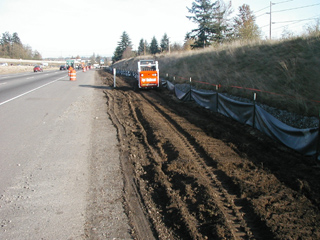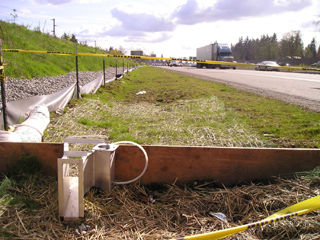
Surveys
DJC.COM
June 28, 2007
Cleaning up stormwater runoff on freeways
Herrera Environmental Consultants

Lenth
|
Given future growth projections for the Puget Sound region, controlling and treating stormwater runoff in urban areas will become an increasing priority if we are to protect salmon and other cherished resources.
Stormwater runoff often contains high levels of pollutants and may increase erosion in nearby streams, leading to water quality issues and degrading fish habitat. Historically, “end-of-pipe” treatment solutions such as large detention vaults and ponds were used to slow down flows, promote settling of sediment, and provide some biological treatment before the runoff is discharged to streams.
More recently, the concept of low-impact development (LID) has become widely accepted as a potentially superior method for treating stormwater runoff. LID systems are designed to mimic the water balance of natural systems by infiltrating as much runoff as possible close to its origin. This reduces the amount of runoff that is generated in the first place and obviates the need for costly and difficult-to-maintain detention vaults and ponds.

Images courtesy of Herrera Environmental Consultants A pilot compost-amended vegetated filter strips system was built along I-5 in Snohomish County. |
Recognizing the potential benefits of LID treatment measures, the Washington State Department of Transportation (WSDOT) is conducting several studies designed to accurately measure what water quality and flow control benefits can be provided by LID systems. Herrera Environmental Consultants is leading several of these studies, including one to examine the benefits of compost-amended vegetated filter strips.
What are CAVFS?
Compost-amended vegetated filter strips (CAVFS) are a design variation of the vegetated filter strip, a LID technique for treating stormwater runoff. Vegetated filter strips are land areas with amended soils and planted vegetation that intercept runoff from highways or other impervious surfaces before it discharges to a nearby body of water. They remove sediments and other pollutants flowing off the pavement by reducing runoff velocities; settling and trapping sediment and other pollutants; and providing some infiltration and biological treatment.

Stormwater runoff is being measured at flow monitoring stations. |
Research indicates that compost amendment can improve filter strip treatment performance by: increasing surface roughness, improving moisture retention and infiltration capacity of the soil, removing contaminants, and promoting vegetative health while limiting the spread of invasive weeds. CAVFS are constructed by tilling compost about 12 inches deep into the surface of a regular vegetated filter strip.
The primary goal of the CAVFS monitoring project is to document the benefits of compost amendment in filter strips for reducing highway runoff volumes. A secondary goal is to document the benefits of compost amendment for improving the water quality treatment performance of filter strips. The project is funded through a grant provided by the Federal Highway Administration with supplemental budgetary support coming from WSDOT.
Monitoring LID systems
Accurate monitoring of LID systems is complex because of the high number of variables that can affect performance and the accuracy of the data. In addition, the monitoring itself can also pose logistical challenges because stormwater entering these systems is typically not concentrated in a single pipe; rather, it is spread out over a large area in order to promote infiltration.
The experimental design for the CAVFS monitoring project involved the construction of three separate pilot filter strips along Interstate 5 in Snohomish County in accordance with WSDOT specifications. Two of these filter strips were amended with tilled-in compost, while a third received no compost.
Automated equipment was installed in association with each filter strip to allow continuous monitoring of influent and effluent flow rates and quantities over the 4-year study period. These data are analyzed to assess the performance of the pilot filter strips for reducing runoff volumes, peak discharge rates and flow durations.
Automated water quality sampling equipment is used to collect influent and effluent samples during individual storm events over the study period. These samples are analyzed for common pollutants in highway runoff including suspended sediment, heavy metals, nutrients and petroleum hydrocarbons.
The water quality treatment performance of each filter strip is assessed by comparing the concentrations and total quantity of each pollutant in the associated influent and effluent. Herrera designed and constructed the pilot filter strips in the fall of 2004. Monitoring of these systems initiated in the winter of 2004 and will continue until September 2008.
Initial results
Data obtained from the first three years of monitoring indicate filter strips are highly effective treatment systems for reducing peak flows and quantities of highway runoff. For example, comparisons of influent and effluent flow rates showed that runoff volumes, peak discharge rates, and flow durations were reduced on average by 93, 91 and 86 percent, respectively, through treatment within the filter strips. Furthermore, compost amendment appears to improve filter strip performance for reducing runoff volumes. Runoff volumes in filter strips with compost amendment were 45-50 percent lower than those in the filter strip without similar amendment.
The data also indicate that filter strips are highly effective for removing common pollutants in highway runoff. For example, concentrations of suspended solids, total phosphorus, particulate-bound heavy metals (i.e., copper and zinc) and petroleum hydrocarbons were reduced 80-90 percent through treatment within the filter strips. Compost amendment also improves the water quality treatment performance of the filter strips by reducing the runoff volumes and, thus, overall loads of each monitored pollutant.
In addition to technical issues, challenges on the project have included protecting equipment from repeated vandalism, dealing with an extremely dry year in 2004, and scientific detective work to determine reasons for performance differences between the test plots.
The complete data set in 2008 will provide extremely robust information that will be used to tailor future LID designs to provide the most environmental benefit for WSDOT’s construction dollars spent.
John Lenth is a senior environmental scientist with Herrera Environmental Consultants where he works primarily on projects relating to water quality, hydrology and aquatic ecology. He also specializes in the statistical analyses of data from water resource studies. He has been with Herrera for more than 10 years.
Other Stories:
- What to know when buying a contaminated site
- New Seattle hotel to marry luxury with green
- Lakehaven solves water woes with ASR
- Treating rural wastewater is a daunting task
- The Emerald City’s tourist industry turns green
- Are nanomaterials another environmental worry?
- Tribe’s waste plant doesn’t raise a big stink
- When BMPs can’t meet stormwater permit rules
- Contaminated site? Let Mother Nature help
- Why integrated design is off to a slow start
- Study your options when banking or reserving wetlands
- Developers must dodge newly discovered fault hazards
- A solution to our dwindling water supply lies below
- Blending a new community into the environment
Copyright ©2009 Seattle Daily Journal and DJC.COM.
Comments? Questions? Contact us.